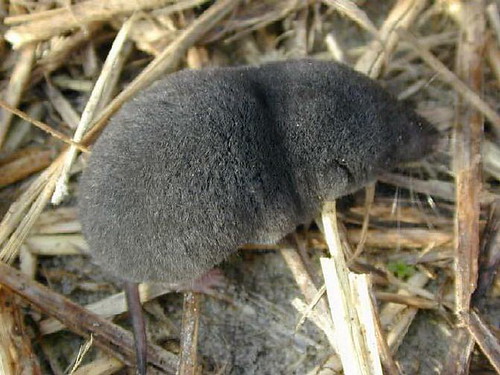Malayan water shrew
The Malayan water shrew ( Chimarrogale hantu ) is a living in Southeast Asia shrew of the genus beaver shrews. Very little is known about the endangered species.
Features
The Malayan water shrew is equipped with a head-body length of eight to twelve inches and a tail length of six to ten centimeters relatively large. The weight is approximately 30 grams. The adapted to locomotion under water body is streamlined, with short legs and a, in relation to body size, long and brown hairy tail. The proof and water resistant coat is back dark gray, sometimes dyed to brownish as possible. The belly is light gray or white. The Malayan water shrew has a long snout, tiny eyes and barely visible ears. The feet carry a Borstensaum, which performs the function of a floating skin. Immerse the Malayan water shrew, close the small flap of skin, the ear openings.
Dissemination
This Malayan water shrew is known only from a very small area in the tropical rain forest of the Malay Peninsula. Hulu Langat in the Forest Reserve, Hulu Langat district, Selangor, Malaysia, it inhabits small rivers and Ufersäume of rivers.
Ecology
Since the initial description by the British zoologist and later a professor at the National University of Singapore, John Leonard Harrison, new insights into the ecology of Malayan water shrew were hardly won. Then she lives on clear streams and captured insects, aquatic insect larvae, small crustaceans and shrimp and fish under water. The few other publications prioritize taxonomic issues and repeat Harrisons information. Only Stone refers to deposits up to 3300 meters altitude.
Threats and conservation
The Malayan water shrew, which relies on clear and clean water, suffers from the destruction of their habitats by deforestation, sedimentation and water pollution. Occasionally it becomes entangled in fishing nets and fish traps. The IUCN Action Plan for all Eurasian insectivores and forest shrews, launched in 1995, will also contribute to the preservation of the Malay water shrew. To this end, studies are in the habitat Hulu Langat Forest Reserve and in neighboring Temegor Forest Reserve. Due to the habitat situation, the Malayan water shrew in the IUCN Red List is classified as "low risk". At the same reasoning, however, points to the limited resources in a by human encroachment, deforestation and expanding agriculture increasingly threatened habitat, so that the continued existence of this species is endangered.










